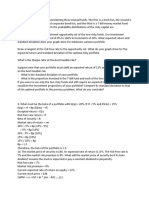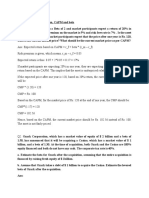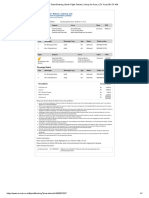Tutorial 9 Questions
Uploaded by
Amber Yi Woon NgTutorial 9 Questions
Uploaded by
Amber Yi Woon NgTutorial 9 Questions
1. Suppose investors believe that the standard deviation of the market-index portfolio has
increased by 50%. What does the CAPM imply about the effect of this change on the
required rate of return on Google’s investment projects ?
2. Consider the statement: “If we can identify a portfolio with a higher Sharpe ratio than
the S&P 500 Index portfolio, then we should reject the single-index CAPM.” Do you
agree or disagree ? Explain.
3. Are the following true or false ? Explain.
(a) Stocks with a beta of zero offer an expected rate of return of zero.
(b) The CAPM implies that investors require a higher return to hold highly volatile
securities.
(c) You can construct a portfolio with a beta of 0.75 by investing 0.75 of the
investment budget in government bonds and the remainder in the market
portfolio.
4. Here are data on 2 companies. The rate of government bond is 4% and the market risk
premium is 6%.
Company $1 Discount Store Everything $5
Forecast return 12% 11%
Standard deviation of 6% 10%
returns
Beta 1.5 1.0
What should be the expected rate of return for each company, according to the capital
asset pricing model (CAPM) ?
5. Characterise each company in the previous problem as underpriced, overpriced or
properly priced.
6. What is the expected rate of return for a stock that has a beta of 1 if the expected return
on the market is 15% ?
(a) 15%
(b) More than 15%
(c) Cannot be determined without the risk-free rate.
7. Kaskin Inc. stock has a beta of 1.2 and Quim Inc. stock has a beta of 0.6. Which of the
following statements is most accurate ?
(a) The equilibrium expected rate of return is higher for Kaskin than for Quinn.
(b) The stock of Kaskin has higher volatility than Quinn.
(c) The stock of Quinn has more systematic risk than that of Kaskin.
8. What must be the beta of a portfolio with E(rp) = 20%, if rf = 5% and E(rm) = 15% ?
9. The market price of a security is $40. Its expected rate of return is 13%. The risk-free
rate is 7%, and the market risk premium is 8%. What will the market price of the
security be if its beta doubles (and all other variables remain unchanged)? Assume the
stock is expected to pay a constant dividend in perpetuity.
You might also like
- CFA Level 1 Calculation Workbook: 300 Calculations to Prepare for the CFA Level 1 Exam (2024 Edition)From EverandCFA Level 1 Calculation Workbook: 300 Calculations to Prepare for the CFA Level 1 Exam (2024 Edition)4.5/5 (6)
- Bodie, Kane, Marcus, Perrakis and Ryan, Chapter 7: Answers To Selected ProblemsNo ratings yetBodie, Kane, Marcus, Perrakis and Ryan, Chapter 7: Answers To Selected Problems12 pages
- R R + (B X (R - R) ) : Required Return On Asset I Risk-Free Rate of Return Beta Coefficient Market ReturnNo ratings yetR R + (B X (R - R) ) : Required Return On Asset I Risk-Free Rate of Return Beta Coefficient Market Return2 pages
- BBMF 2093 Corporate Finance: Characteristic Line (SML) Slope of The Line To Be 1.67No ratings yetBBMF 2093 Corporate Finance: Characteristic Line (SML) Slope of The Line To Be 1.676 pages
- Nanyang Business School AB1201 Financial Management Seminar Questions Set 5: Risk and Rates of Return (Common Questions)No ratings yetNanyang Business School AB1201 Financial Management Seminar Questions Set 5: Risk and Rates of Return (Common Questions)3 pages
- Financial Management - Theory & Practice by Brigham-266-273No ratings yetFinancial Management - Theory & Practice by Brigham-266-2738 pages
- MBA 4 Sem I M Unit IV Probs On Portfolio TheoryNo ratings yetMBA 4 Sem I M Unit IV Probs On Portfolio Theory5 pages
- Essentials of Investments 9th Edition Bodie Solutions Manual - Complete Set Of Chapters Available For Instant Download100% (2)Essentials of Investments 9th Edition Bodie Solutions Manual - Complete Set Of Chapters Available For Instant Download50 pages
- Chapter 7 Risk and Return_Student versionNo ratings yetChapter 7 Risk and Return_Student version6 pages
- Tutorial 8: Chapter 9 The Capital Asset Pricing Model: Expected Retrun Higher, Stock Price Lower)No ratings yetTutorial 8: Chapter 9 The Capital Asset Pricing Model: Expected Retrun Higher, Stock Price Lower)4 pages
- FM1 04 Investment Risk and Return Excercises0% (1)FM1 04 Investment Risk and Return Excercises2 pages
- Ques Risk and Return & CAPM (S-17Revised)No ratings yetQues Risk and Return & CAPM (S-17Revised)6 pages
- Nanyang Business School AB1201 Financial Management Tutorial 5: Risk and Rates of Return (Common Questions)No ratings yetNanyang Business School AB1201 Financial Management Tutorial 5: Risk and Rates of Return (Common Questions)3 pages
- DIVIDEND INVESTING: Maximizing Returns while Minimizing Risk through Selective Stock Selection and Diversification (2023 Guide for Beginners)From EverandDIVIDEND INVESTING: Maximizing Returns while Minimizing Risk through Selective Stock Selection and Diversification (2023 Guide for Beginners)No ratings yet
- Outperform with Expectations-Based Management: A State-of-the-Art Approach to Creating and Enhancing Shareholder ValueFrom EverandOutperform with Expectations-Based Management: A State-of-the-Art Approach to Creating and Enhancing Shareholder ValueNo ratings yet
- Press Release Competitive Examinations 2024No ratings yetPress Release Competitive Examinations 20248 pages
- Melchizedek in The Bible, The Qumran Texts (11q, 1965), and100% (1)Melchizedek in The Bible, The Qumran Texts (11q, 1965), and21 pages
- The Mahavadanasutra A New Edition Based On Manuscripts Discovered in Northern Turkestan Sanskrit Worterbuch Beihefte Takamichi Fukita100% (2)The Mahavadanasutra A New Edition Based On Manuscripts Discovered in Northern Turkestan Sanskrit Worterbuch Beihefte Takamichi Fukita64 pages
- AffinHwang Capital - JAKS Resources Berhad - Third Time Lucky 18-08-2015No ratings yetAffinHwang Capital - JAKS Resources Berhad - Third Time Lucky 18-08-201517 pages
- Get Class 8 Civics Chapter 6 Confronting Marginalisation Notes FREE PDFNo ratings yetGet Class 8 Civics Chapter 6 Confronting Marginalisation Notes FREE PDF4 pages
- Online Re-Sessional 2examination: Semester: 8 Sem Subject: DF SR - No Question Options Correct AnswerNo ratings yetOnline Re-Sessional 2examination: Semester: 8 Sem Subject: DF SR - No Question Options Correct Answer5 pages
- ZZ Legal Education and Research MethodologyNo ratings yetZZ Legal Education and Research Methodology2 pages
- IIA IIA-CIA-Part1 Free Practice Exam & Test TrainingNo ratings yetIIA IIA-CIA-Part1 Free Practice Exam & Test Training2 pages
- The Icon in The Life of The Church - George Galavaris100% (2)The Icon in The Life of The Church - George Galavaris109 pages
- Air Ticket Booking - Book Flight Tickets - Cheap Air Fare - LTC Fare - IRCTC AIR0% (1)Air Ticket Booking - Book Flight Tickets - Cheap Air Fare - LTC Fare - IRCTC AIR1 page
- CAPM Proof That Market Portfolio Is Value WeightedNo ratings yetCAPM Proof That Market Portfolio Is Value Weighted3 pages

























































































